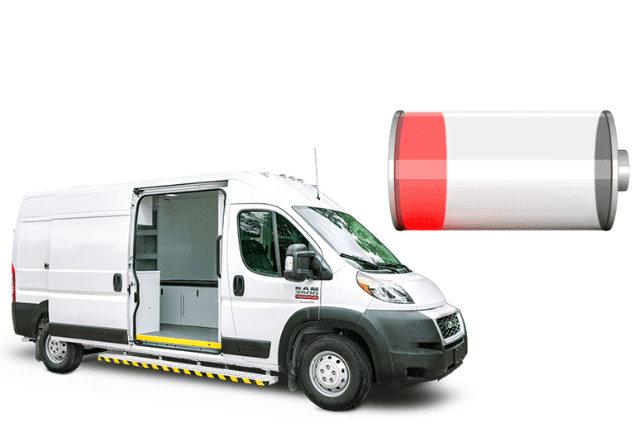Suppose you’re an organization in the healthcare industry that provides healthcare to patients around the U.S. One of the most frustrating issues you might face is unexpected battery drainage in mobile medical vehicles. Imagine being on the road, rushing to provide medical care, and suddenly, your vehicle’s battery dies.
This inconvenience can be life-threatening for the patients who rely on your mobile health services. The stress of not being able to reach a patient in need, the anxiety of unpredictable downtimes, and the frustration of dealing with complex vehicle issues can be overwhelming. You need a reliable solution and deserve peace of mind knowing your mobile medical unit is always ready to serve.
At AVAN Mobility, we deeply understand these concerns. With over a decade of expertise and hundreds of successful mobile medical units delivered, including our recent partnership with Celebrating Life Community Health Center, we have earned a reputation as an industry leader.
In this article, we’ll dive into the five main causes of battery drainage in mobile medical vehicles. After you’re done reading, you’ll understand these causes and learn practical solutions to keep your vehicles running smoothly. We aim to inform, educate, and empower you to make the best decisions for your organization. Let’s get started!
What is battery drainage in a mobile medical vehicle?
Battery drainage in a mobile medical vehicle happens when its battery loses its charge faster than it should. This can leave the vehicle unable to start or power medical equipment. Here’s a simple way to understand it:
Think of a battery like a bucket of water. When you use the vehicle or its equipment, you’re taking water out of the bucket. Normally, the engine or an external charger puts water back in.
Battery drainage means that water is leaving the bucket faster than it’s being refilled. If the bucket runs dry, the vehicle can’t run, and the medical equipment can’t work.
Why is this a problem?
Dealing with battery drainage in a mobile medical vehicle is extremely frustrating for a few reasons.
You may get stranded: Your vehicle might stop working during an important medical trip, leaving you stuck on the side of the road in a remote area.
Healthcare mission disruption: Scheduled medical services might get delayed or canceled, affecting the overall efficiency of your operations.
Stress and Anxiety: It can cause constant worry about whether your vehicle will start or not the next day.
Increased costs: Frequent battery replacements or repairs can add up and put a strain on your organization’s budget.
Reputation damage: Consistent vehicle issues can lead to dissatisfaction among patients who rely on your services, potentially harming your organization’s reputation.
Interested in how to maintain your mobile clinic? Click the button below to check out the mobile clinic maintenance checklist.
Key signs of battery drainage
There are a couple of battery drainage signs to be mindful of:
- Slow engine start: The engine takes longer than usual to start.
- Dim lights: The vehicle’s lights might be dimmer than normal.
- Frequent jump-starts: You often need to jump-start the vehicle.
- Warning lights: Dashboard warning lights for the battery or electrical system frequently illuminate.
Understanding battery drainage is the first step in preventing it. In the next sections, we’ll explore the top 5 causes of this issue and provide practical solutions to keep your mobile medical unit running smoothly.
What are the causes of battery drainage in mobile medical vehicles?
Keep reading to learn about the top 5 causes of battery drainage in mobile medical vehicles.
1. Faulty alternator
A faulty alternator is one big cause of battery drainage in mobile medical vehicles. The alternator keeps the battery charged while the vehicle is running. If it’s not working right, the battery won’t get charged and will drain quickly. This can end up leaving you stranded and unable to provide health services.
What’s the solution?
Follow these tips to prevent alternator issues:
- Electrical system inspections: Schedule routine check-ups for your vehicle’s electrical system to ensure the alternator is working properly.
- Dashboard lights: Check your dashboard for a battery warning light sign and also see if your headlights are dimming more than they should be.
- Test the alternator: Have the alternator tested regularly, especially if you notice or suspect any battery issues.
- Prompt repairs: If the alternator is faulty, replace it as soon as possible to avoid unexpected breakdowns.
2. Parasitic drainage
Parasitic drain happens when things in your vehicle keep using the battery, even when the vehicle is turned off. This can include systems like GPS, alarms, or even interior lights that are accidentally left on. Using power continuously can slowly drain the battery and lead to unexpected failures.
What’s the solution?
There are a couple of things you can do to avoid parasitic battery drain:
- Turn off non-essential components: Always check and turn off all non-essential electrical components when the vehicle is not in use.
- Install a battery disconnect switch: This switch lets you cut off power to these components when the vehicle is parked for a long time.
- Monitor power usage: Keep an eye on the power usage of different systems to identify any that might be drawing too much power.
3. Extreme temperatures
Extreme temperatures, both hot and cold, can really affect your vehicle’s battery. Hot weather can make the battery fluid evaporate, and cold weather can slow down the battery, making it harder to hold a charge. This can cause the battery to drain quickly and not last as long.
What’s the solution?
To protect your battery from extreme temperatures, try these tips:
- Park in a garage: If you can, park your vehicle in a garage or a shaded area to keep it out of the heat.
- Use battery insulation: Battery insulation kits help keep the battery temperature stable.
- Routine battery checks: Test your battery regularly, especially before winter and summer, to make sure it’s in good shape.
- Portable jump starter: Keep a portable jump starter in your vehicle in case the battery drains unexpectedly.
These steps can help you deal with temperature-related battery issues and keep your mobile medical unit running smoothly.
4. Age of the battery
An old battery is another common cause of battery drainage. Over time, batteries lose their ability to hold a charge. If your mobile medical vehicle’s battery is several years old, it might be time for a replacement. An old battery can drain quickly and struggle to power all the necessary equipment.
What’s the solution?
To avoid issues with an old battery, follow these steps:
- Check battery age and consider replacement: Most vehicle batteries last between 3 to 5 years. If your battery is older than that, it might be time to replace it.
- Regular Testing: Have your battery tested regularly to check its health. Many auto shops offer this service for free.
- Look for warning signs: Pay attention to signs like slow engine starts or dim lights, which can indicate a failing battery.
- Keep records: Maintain a log of your battery’s age and condition to track when it might need replacing.
Monitoring the condition of your battery will prevent unexpected drainage and keep your vehicle reliable. Let’s take a look at the last cause of battery drainage in mobile medical units.
5. Loose or corroded battery connections
Loose or corroded battery connections can cause your vehicle’s battery to drain quickly. When the battery terminals are loose or covered in corrosion, the battery can’t properly transfer power to the vehicle, leading to poor performance and faster drainage.
What’s the solution?
To prevent issues with battery connections, follow these tips:
- Regular inspections: Check your battery terminals regularly for signs of corrosion or looseness.
- Clean the terminals: Use a mixture of baking soda and water to clean any corrosion off the terminals. A wire brush can help remove stubborn buildup.
- Tighten connections: Make sure the battery terminals are tightly connected. Loose connections can prevent the battery from charging properly.
- Apply protective spray: Use a battery terminal protectant spray to prevent future corrosion.
When you keep your battery connections clean and tight, you can ensure your battery performs well and avoids unnecessary drainage.
Want to learn more about mobile medical vehicles?

You came to this article because dealing with battery drainage in mobile medical vehicles can be stressful and can disrupt your important work. Now, you understand the top five causes of battery drainage and some solutions to address them.
At AVAN Mobility, we’ve manufactured hundreds of mobile medical units for organizations across the country. One of our success stories is a Mobile Clinic Van being used in Joplin, Missouri. Our extensive experience ensures that we understand your needs and can provide reliable solutions.
We understand the challenges you face and are here to support you. If you have any questions or need more help, click the button below to talk to a mobility expert. We’re always ready to assist you in keeping your vehicles on the road, serving those who need you most.
If you’re not ready to talk to someone just yet, we have a few more articles you may be interested in. For starters, we know how important it is to know the cost of a mobile medical vehicle before purchasing one. Check out our mobile medical cost video to learn more about that.
You should also read our article on mobile medical van customization to learn more about your options.





